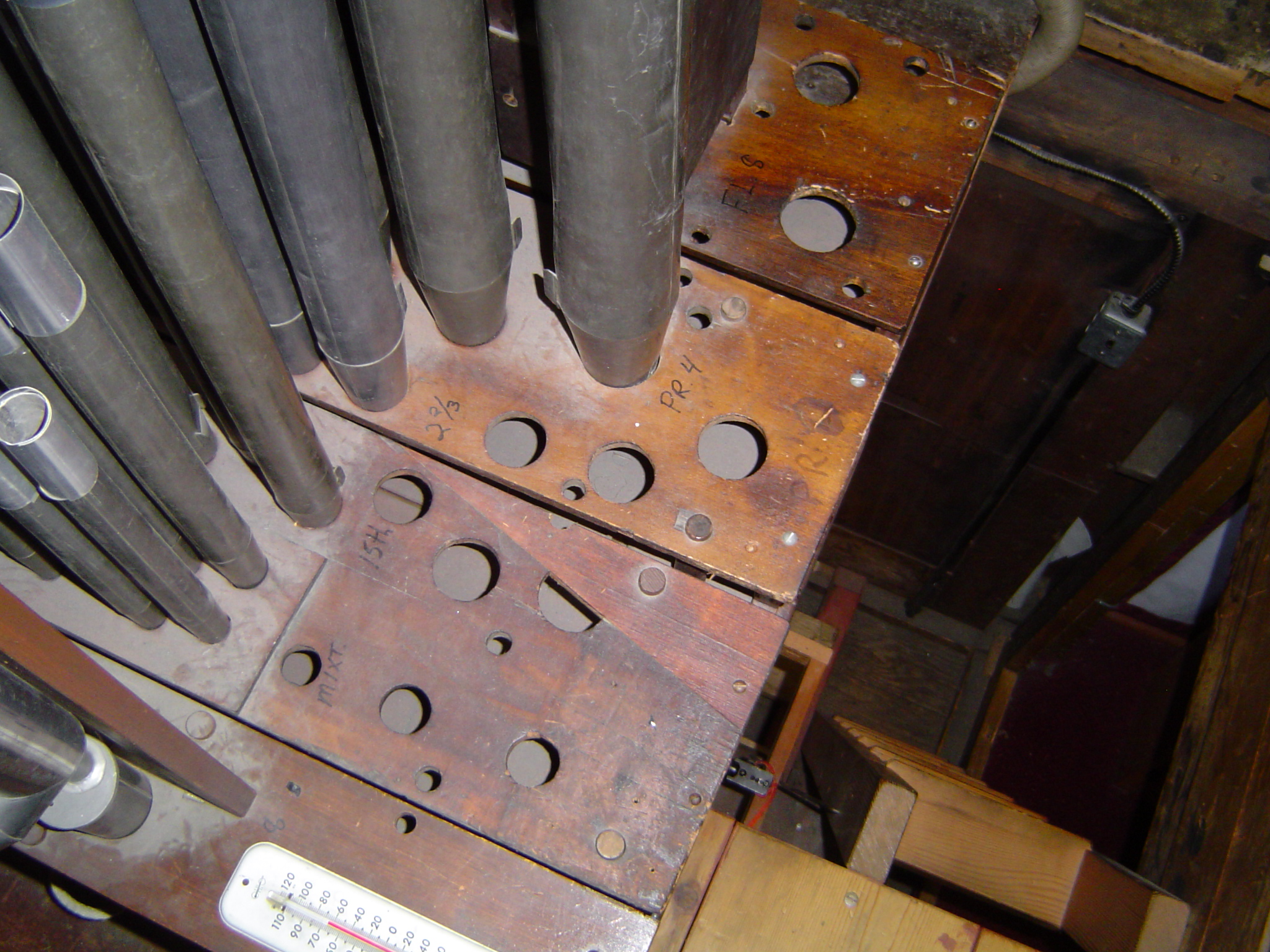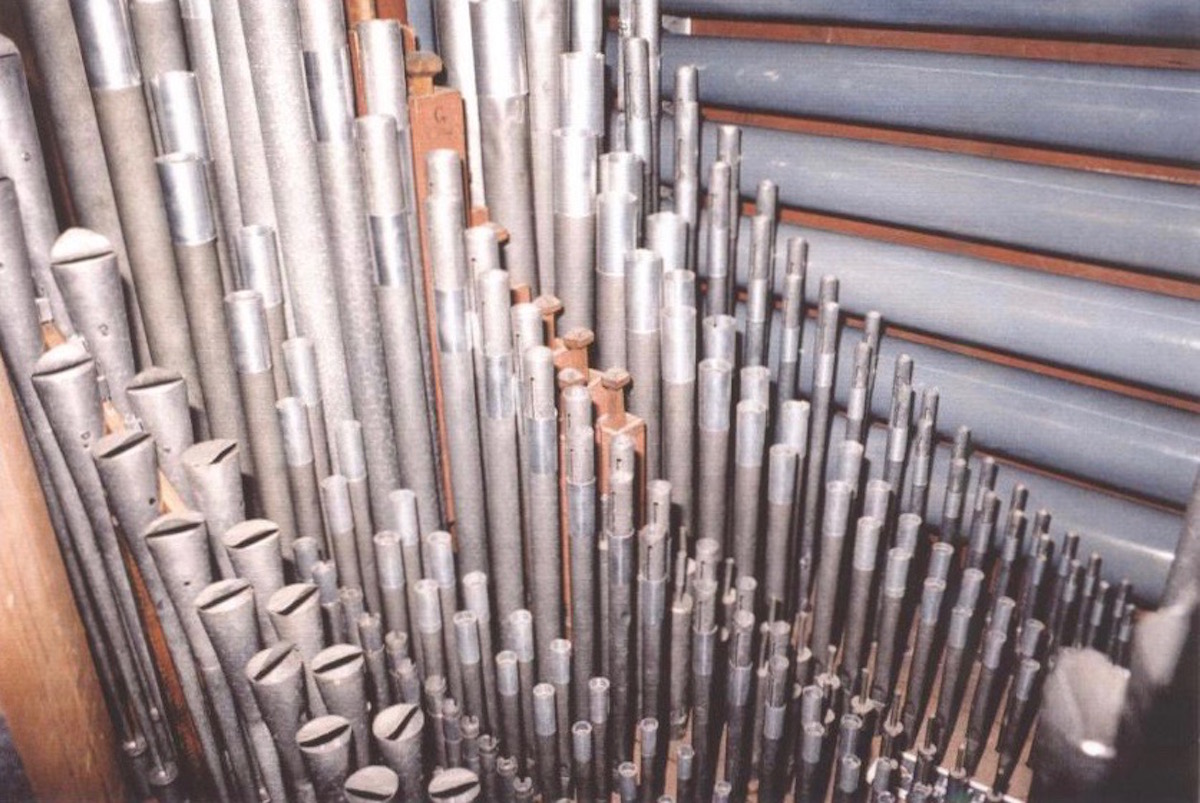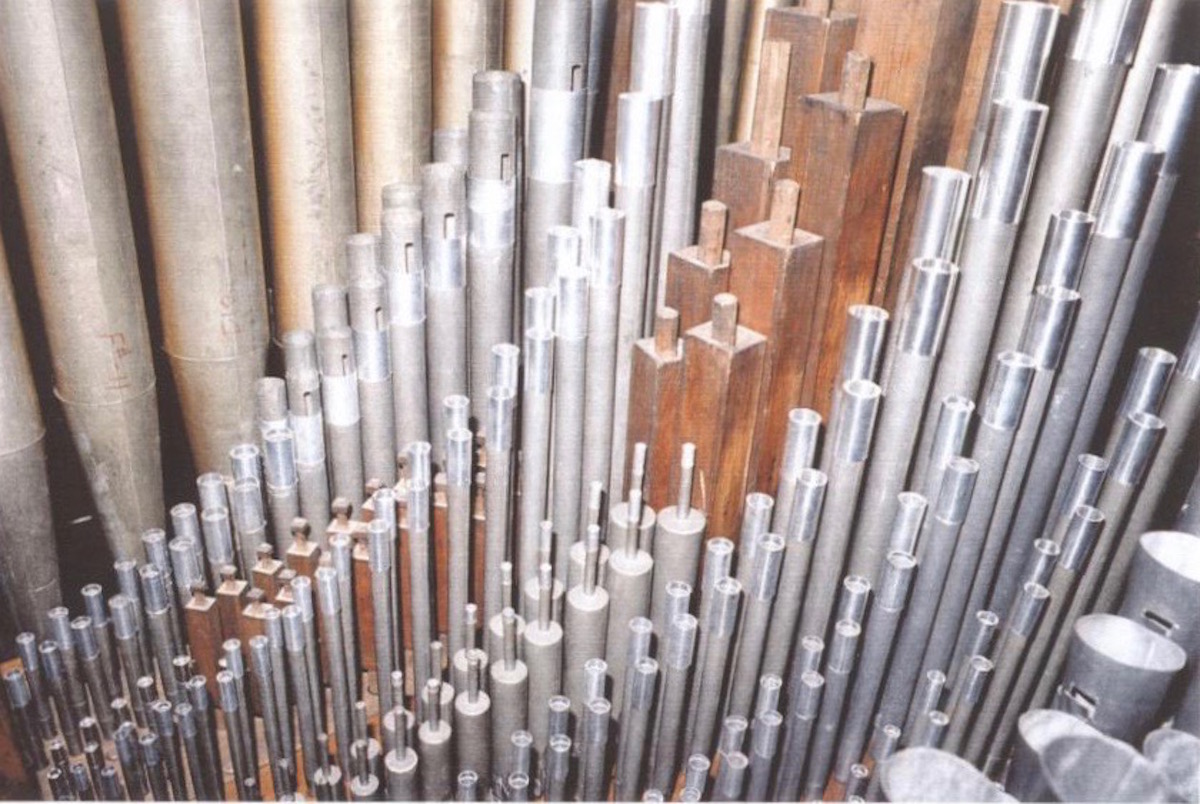Church of Our Lord, Anglican Network In Canada: Sanctuary constructed in 1875
626 Blanshard Street
Victoria, BC, CA
Images
 2019 - This is the C-sharp side of Appleton's Great chest from 1827 showing empty rack board holes for the original G-compass of the keyboard. (Photograph by H. David Vuckson/H. David Vuckson)
2019 - This is the C-sharp side of Appleton's Great chest from 1827 showing empty rack board holes for the original G-compass of the keyboard. (Photograph by H. David Vuckson/H. David Vuckson) 2019-06-19 - Open Wood pipes for notes 1-4 of Great 8 ft. Diapason (Photograph by H. David Vuckson/H. David Vuckson)
2019-06-19 - Open Wood pipes for notes 1-4 of Great 8 ft. Diapason (Photograph by H. David Vuckson/H. David Vuckson) Unknown - Swell Pipework (Photograph by Grant Smalley (1999)/Database Manager)
Unknown - Swell Pipework (Photograph by Grant Smalley (1999)/Database Manager) Unknown - Great Pipework (Photograph by Grant Smalley (1999)/Database Manager)
Unknown - Great Pipework (Photograph by Grant Smalley (1999)/Database Manager) 2015-08-09 - Organ Case (Photograph by Dick Faulks/Database Manager)
2015-08-09 - Organ Case (Photograph by Dick Faulks/Database Manager) 2015-08-09 - Builder's Nameplate (Photograph by Dick Faulks/Database Manager)
2015-08-09 - Builder's Nameplate (Photograph by Dick Faulks/Database Manager) 2015-08-09 - Console (Photograph by Dick Faulks/Database Manager)
2015-08-09 - Console (Photograph by Dick Faulks/Database Manager) 2015-08-09 - Wind Indicator (Photograph by Dick Faulks/Database Manager)
2015-08-09 - Wind Indicator (Photograph by Dick Faulks/Database Manager) 2015-08-09 - Left Drawknobs (Photograph by Dick Faulks/Database Manager)
2015-08-09 - Left Drawknobs (Photograph by Dick Faulks/Database Manager) 2015-08-09 - Right Drawknobs (Photograph by Dick Faulks/Database Manager)
2015-08-09 - Right Drawknobs (Photograph by Dick Faulks/Database Manager) 2015-08-09 - Console (music rack removed) and Key Action (Photograph by Dick Faulks/Database Manager)
2015-08-09 - Console (music rack removed) and Key Action (Photograph by Dick Faulks/Database Manager) 2015-08-09 - Tracker Action (next to Pedal stop) (Photograph by Dick Faulks/Database Manager)
2015-08-09 - Tracker Action (next to Pedal stop) (Photograph by Dick Faulks/Database Manager) 2015-08-09 - Pedal Pipework (Photograph by Dick Faulks/Database Manager)
2015-08-09 - Pedal Pipework (Photograph by Dick Faulks/Database Manager) 2015-08-09 - Pedal Pipework (Photograph by Dick Faulks/Database Manager)
2015-08-09 - Pedal Pipework (Photograph by Dick Faulks/Database Manager) 2015-08-09 - Double-Rise Reservoir (Photograph by Dick Faulks/Database Manager)
2015-08-09 - Double-Rise Reservoir (Photograph by Dick Faulks/Database Manager) 2015-08-09 - Action (Photograph by Dick Faulks/Database Manager)
2015-08-09 - Action (Photograph by Dick Faulks/Database Manager)
Consoles
Main
- 2 manuals
- 21 stops
- 17 registers
- 3 divisions
- Key action Type: Mechanical (Details Unknown)
- Stop action Type: Mechanical
- Manual compass: 54 notes
- Pedal compass: 30 notes
Notes
2009-05-26 - Addition of Swell division to Appleton organ of 1827. -Database Manager
2015-06-23 - Rebuilt by S. S. Hamill 1867 as 2m. Moved from unknown location by John Bergstrom c. 1876. Restorative repairs by Grant Smalley 1994. (OHS PC Database. 2004-10-30)
**NEW INFORMATION**: This organ was examined by the OHS in 1982 following the convention in Seattle. The conclusion was that S. S. Hamill did not actually add a Swell to a one manual organ, but rather rebuilt a short compass Swell into a full compass Swell with a new chest. This was written up in *The Tracker* Vol. 27, No. 4, 1983 by Barbara Owen under the title, *An Early New Engand Organ on the West Coast. -Database Manager
2015-06-23 - Updated through online information from H. David Vuckson. -- This organ was installed in this church in December 1875. The console had folding doors at one time in its life; they are long-gone. The lone pedal stop (originally 17 notes) is labelled "Pedal Diapason" but is actually a Bourdon. One theory is that this was, at one time, an Open Wood and that it was cut in half at some time in the organ's history. <br> There is also an empty drawknob hole for, it appears, a long-gone 8 ft. pedal stop. The hand pumping handle is disconnected and stored inside the case. The water engine of 1879 has long since been replaced with a modern blower. The oldest parts of this organ are approximately 188 years old--the Great chest has empty pipe holes from the original GG compass. It is played every Sunday and still makes a glorious sound. Much remedial work was done on it in the 1990's. <br> Still, at this age, it has its quirks (runs, arthritis, etc.). It does not enjoy the occasional spell of cold/dry weather that we sometimes get in the winter. I have assisted in the instrument's maintenance for many years. -Database Manager
2017-06-03 - Updated by H. David Vuckson -Database Manager
2017-06-04 - Updated by H. David Vuckson <br>
For about 140 years there has been a "legend" that this organ, while on-board a ship, was "thrown overboard in a shipwreck" then subsequently salvaged and purchased by Sir James Douglas (the "Father" of British Columbia) and donated to the new Church Of Our Lord. The legend was expanded over the years and according to different sources, this alleged shipwreck occurred in at least six different locations on the west coast between Burrard Inlet (Vancouver) and San Francisco and points in between. This, of course, is nonsense. What actually happened is quite different. From the reports in the British Colonist newspaper, Victoria, B.C. in December 1875 comes this information: The dual steam/sail ship "Los Angeles" departed San Francisco on Monday, November 29, 1875 under the command of Captain Charles Thorn with 236 tons of freight (including the organ) and 49 passengers for Victoria as well as freight and passengers for ports on Puget Sound. Among the passengers for Victoria was San Francisco organ builder John Bergstrom who had worked on the organ for some years in that city. The ship, formerly a revenue cutter named "Wyanda", was long and narrow. After being condemned it was sold to new owners who built cabins and houses on the deck resulting in a top heavy ship with two-thirds of it out of the water. By December 8, 1875 the Los Angeles had not arrived in Victoria and it was feared she might have rolled over in bad weather. Her machinery had broken down on Wednesday, December 1st, and the sails were put up. She was running ahead of the wind until on Sunday, December 5th the wind turned into a gale. A crew member named James Walsh was washed overboard and lost at sea that day. The disabled Los Angeles was towed into Esquimalt harbour near Victoria by a Royal Navy tug, "H.M.S. Rocket" on December 8th. The freight survived intact and a glowing testimonial was presented to Captain Thorn and his crew by the grateful passengers for their safe arrival. The organ, purchased by Sir James Douglas, was transported to the brand new Church Of Our Lord and set up by John Bergstrom and was ready to be played (hand-pumped) by the end of December. The church was formally opened on Sunday, January 16, 1876 and the organ has been in continuous use since that time. -Database Manager
2023-01-18 - January 17, 2023. New information has come to light that references this organ. The information comes from the book *Memoirs Of A San Francisco Organ Builder* by Louis J. Schoenstein, published in 1977. Page 133:
"**CHURCH OF THE ADVENT -- EPISCOPAL** [San Francisco]
According to the records left by my father, the first Church of the Advent was located on the south side of Howard Street, opposite New Montgomery Street. It was founded in 1859...Other available notes place the location at Mission Street near Second Street.
The church had a two manual and pedal tracker action organ, undoubtedly of some Eastern builder. The key desk was attached and it had a high Gothic case. An unusual feature of the manual keyboards was that their fronts were covered with black walnut and not ivory or celluloid, as is usually the case. Evidently, as the church wanted a more modern and better organ, the old organ was disposed of in 1882 [actually 1875] and sold to some church in Victoria, British Columbia. My father dismantled the organ, packed it and had it shipped to its destination."
Although the date 1882 is wrong, this does appear to describe the organ at Church Of Our Lord; the key fronts have dark wood on them; the case is Gothic (possibly from the 1867 rebuild in New England by S. S. Hammill of Appleton's original facade). The Church of the Advent was destroyed in the 1906 San Francisco earthquake and fire.
The organ still plays every Sunday and its vintage pipes (the majority of them original Appleton according to the OHS who examined it in 1982) continue to raise their voices in glorious praise. The King of Instruments in service to the King Of Kings. -H. David Vuckson
Stoplist
Stoplist from the console April 25, 2015 Source: Source not recorded Date not recorded
Victoria, British Columbia,Canada
Church Of Our Lord (Anglican Network in Canada
Thomas Appleton Organ: circa 1827
GREAT
8' Open Diapason 54 pipes (1-4 Open Wood)
8' Stopped Diapason Bass 17 pipes
8' Stopped Diapason Treble 37 pipes
8' Dulciana (Tenor F) 37 pipes
4' Principal 54 pipes
4' Flute (Tenor F) 37 pipes
2 2/3' Twelfth 54 pipes
2' Fifteenth 54 pipes
II Mixture 108 pipes
8' Trumpet 54 pipes
Swell to Great Coupler
SWELL
8' Open Diapason 54 pipes
8' Viol di Gamba(Tenor C) 42 pipes
8' Celeste Bass (Tenor C) 5 pipes
8' Celeste Treble 37 pipes
8' Stopped Diapason Bass 12 pipes
8' Stopped Diapason Treble 42 pipes
4' Principal 54 pipes
Mixture (1-12 II/13-54 III) 150 pipes
8' Bassoon 12 pipes
8' Hautboy 42 pipes
Tremulant
PEDAL
16' Bourdon 30 pipes
Swell to Pedal Coupler
Great to Pedal Coupler
*Celeste in Swell was originally a Bourdon
*Drawknob for Pedal Bourdon labelled "Pedal Diapason"
[Received from H. David Vuckson June 20, 2015]
Related Pipe Organ Database Entries
Other Links
Regrettably, it is not possible to display the information about the sponsor of this pipeorgandatabase entry or if there is a sponsor. Please see About Sponsors on Pipe Organ Database.















